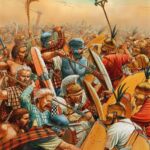Aurora was the goddess of morning light, dawn and dawn (morning). She was a deity associated with the cult of the dawn. Identified with the Greek Eos.
Its origin is unclear. According to Ovid, she could have been Pallantis, that is, the daughter of either Pallas or Hyperion and Teja’s wife. She had two siblings: a brother (Sol, the Sun) and a sister (Luna, the Moon). Her first husband was a titan – Astraeus. They had several sons: Favonius (west wind), Aquilo (north wind), Auster (south wind) and Eurus (east wind). Other sons are Phosphorus (Morning Star) and Hesperos (Evening Star). Over time, Aurora’s beauty would captivate Mars, which Venus did not like. This goddess made Aurora fall in love with a mortal.
Aurora appears frequently in Roman erotic poetry due to many love stories. The Romans adapted the Greek myth in which the goddess falls in love with the prince of Troy – Titonos. Titonos was mortal, so by the laws of nature he had to grow old and die. Aurora, wanting to have her love with her forever, asked Jupiter for immortality for the prince. However, the goddess forgot to mention to Jupiter that Titonos should be forever young. Therefore, he was to live forever, but in the form of an old man. The goddess finally decided to turn him into a grasshopper.
In ancient Roman art, it was most often depicted after the Greek example of Eos. She was usually depicted as a pretty woman with huge wings at her shoulders, in a peplos of saffron (intense yellow) colour, driving a two-horse chariot or flying in front of Sol’s cart, with flowers and a torch in her hand.
According to the beliefs, each dawn she travelled across the sky on a light chariot, drawn by a pair of white or pink horses – Lampos (Shining, Bright) and Phaeton (Radiant, Shining). It started (emerging from the waves of Oceanos) in the East and ended (plunging into the waves of Oceanos) in the West, on the other side of the horizon. She opened the “gates of the day” (the gates of heaven) in front of Sol’s wagon. It dispersed the darkness of the night, heralded the light of day to people and gods. Its arrival was announced by Phosphorus (the Morning Star) – “the shining son of Dawn”.







